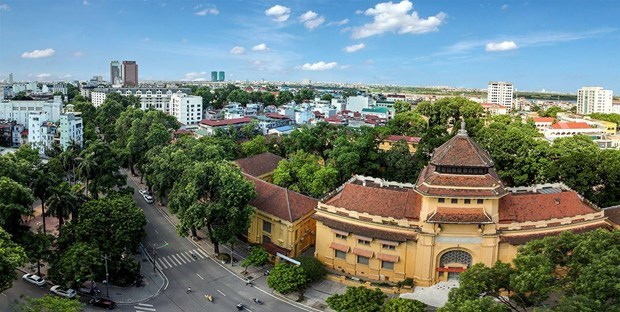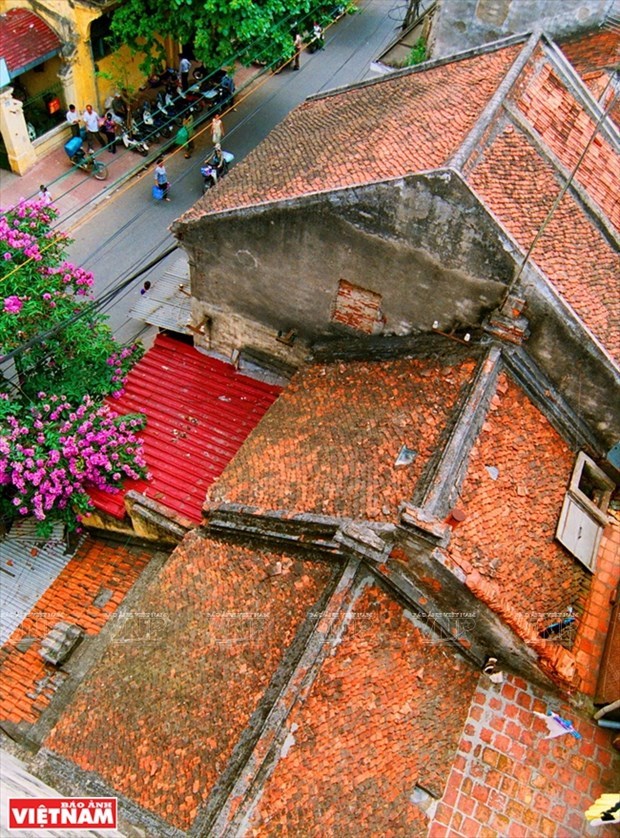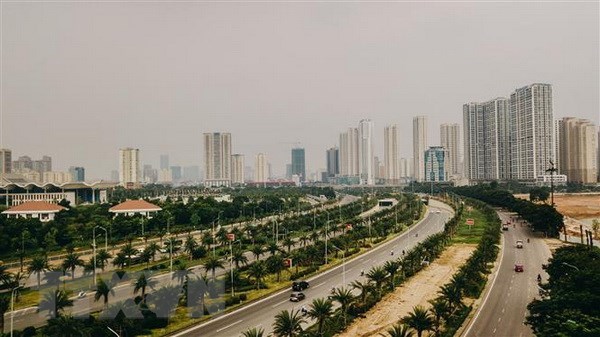 |
|
A corner of Hanoi
|
Its charm partly derives from oriental and French-style architecture, both ancient and modern, that will exist forever over time.
Ancient architecture in the Old Quarter
 |
|
A corner of Hanoi Old Quarter
|
Whenever mentioning Hanoi, itis impossible not to notice the Old Quarter, which has earned Hanoi the name “Acity of 36 streets”.
According to the history, theHanoi Old Quarter was formed in around the 10th century, andflourished from the 15-16th century. It sprawls over 82ha to theeast of the Thang Long Imperial Citadel, and now spreads over 10 wards of HoanKiem district – the heart of Hanoi.
Though called “Hanoi – 36streets”, the Old Quarter in fact has more than 36 streets. It is a common namethat has been widely recognised.
The Old Quarter used to be aplace where people from all around the Northern Delta gathered and then turnedit into the busiest area of the city, with craft and trade activities. Each streethoused craftsmen from well-known craft villages and became a miniature villagein the heart of Hanoi.
Each street is also namedafter the type of goods or service for sale, starting with the word “Hang”(goods), such as Hang Duong, Hang Bac, Hang Mam, Hang Chinh, Hang Ma, Hang Vai,and more.
Though now many items are nolonger available for sale on several streets, they are still remindful of avery special period in the Vietnamese history.
The old quarter has a veryunique urban feature, where streets are bustling all the time, but stillretains the thousand-year traditional cultural values of the capital land.
Built in the18th and 19th centuries, houses in this quarter weresmall, tube-shaped and roofed with thatch leaves or tiles. Most of them have abrick structure with wooden beams or a structure of force-resistant woodenbeams with raising pieces supporting the tiles.
To make thebeams, precious timbers, such as Dinh (Markhamia stipulate), teakwood andironwood were used.
However,what astonished researchers as well as today’s generation is that allcalculations for making the house structures were made by workers who had neverattended a training course, but only depended on their traditional experience.
In the late 19th and 20th centuries, most houses had a roof made of double tiles ortoe cape-shaped tiles. The edges of the roof were decorated with patterns of anold architectural style, creating natural waves.
In the 1920s, houses with roofs of the Indochinese style appeared, includingsloping tiled roofs and overlapping tiled roofs, which has similar advantagesas the Vietnamese traditional ones.
Many visitors visiting theOld Quarter will feel like returning to the past because of the small space andunique architecture, which is completely different from the crowded streetsadjacent to tall buildings or modern works.
First-time visitors, orforeign tourists, may feel overwhelmed, confused when walking on the crowded,narrow streets with houses sitting close together and vehicles crisscrossing. Thescene is probably a bit chaotic for strangers. But in order to see the specialculture and life there, they need to go and feel with their own eyes.
With its time-tested beauty,the Hanoi Old Quarter has become a major theme in numerous paintings bywell-known artist Bui Xuan Phai (1920-1988). Now, whenever mentioning Bui XuanPhai, people think of the
Hanoi Old Quarter, and when it comes to the Hanoi OldQuarter, the name "Pho Phai" (Phai Street) is not strange.
Phai once wrote his feeling about streetsin diary “Hanoi has many beauties, old and new, but each beauty is suitable toeach person. Old streets and houses with deep brown tile roof, walls covered with moss lyingquietly will easily appear beautiful on paintings. Their rhythm is not as even as high-rise buildings andprefabricated houses”.
Hanoi remembered for French colonialbuildings
Hanoi’s beauty is not onlyshown in the Old Quarter, but also a blend of western and orientalarchitecture, notably works built in the late 19th and early 20th centuries such as buildings in the classical French style, luxury villas ownedby French officials or wealthy Vietnamese working for foreigners.
Up to 1,586 French-style buildings andvillas, built over 100 years ago, are conserved at present. As many as 562 ofthem are used by individuals and the remaining owned by the State.
As the first French-builtiron bridge crossing the Red River, Long Bien bridge has spanned threecenturies, witnessing the wars against French colonists and US imperialists,and the development of the capital city. The mixture of classical andcontemporary architecture has made the bridge uniquely special.
Meanwhile, the Hanoi Opera House was modeledafter the famous Palais Opera Garnier in Paris. Its construction was completedin 1911 on August Revolution Square. It isa hard-to-be-missed place when learning about Hanoi culture, especially as its facade is meticulously painted inyellow and white neo-classical colours. Still in regular use, the HanoiOpera House plays host to a variety of theatre arts, symphony, ballet,musical and chorus performances all year round.
Formerly the Governor General of Indochina's Palace, the majesticPresidential Palace was built between 1900 and 1902. Most of the villas in thearea were built in the style of northern France and feature sloping roofs anddecorative elements over the doors and on the roofs.
HoaLoa prison was first built by the French to incarcerate Vietnamese prisonersbut was later used to hold American prisoners of war.
It is both a testimony to theindomitable fighting history of Vietnamese revolutionary soldiers, and aconviction of the barbarous prison regime under the French colonial rule.Because of its historical significance, Hoa Lo prison relic site welcomesthousands of visitors each year, 70 percent of them are foreigners, particularly US ex-soldiers who joined the war in Vietnam.
Skyscrapers rise up in construction boom
 |
|
On Thang Long boulevard
|
In order to understand how the post-war Hanoi is today, it isprobably the best to take the elevator to the 67th floor of thesecond tallest building in Southeast Asia, the Hanoi Lotte Centre – a well-known shopping mall, office andapartment complex.
Like othershopping malls, the complex is often crowded at weekends and has become aregular venue for families or tourists.
Looking at thecity from there, more and more buildings of this kind are on the way. Apartmentsare also being built in great quantity to supply accommodation for a hugepopulation of the modern Hanoi.
 |
|
Keangnam Tower in Hanoi
|
Another highbuilding is Keangnam tower - the highest skyscraper of Hanoi so far. The complex consists of one 72-storymixed-use tower with the height of 350m and two 48-storey hotel twin towers.
The complexfeatures a 5-star that opened on 18 May 2012. Landmark 72 is also the world's35th-highest building and formerly was the highest on Indochina Peninsula./.VNA
 Hanoi, a charming city with a history of over one thousand years, is the convergence of cultural and historical essences of Vietnam.
Hanoi, a charming city with a history of over one thousand years, is the convergence of cultural and historical essences of Vietnam.